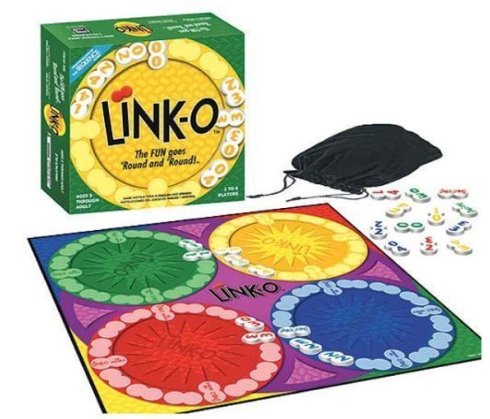 |
| Link-O - Similar to dominoes, match color and number on a game board |
A quick definition is that Link-O is like rounded dominoes played on a game board. The tile pieces are solid plastic (they are made like modern-day dominoes - not wood) and have 2 numbers each, from zero to four. Both numbers are the same color. You play the tiles on a board, matching like numbers as you go. The black game bag is a nice heavy silky-type material with draw strings.
There are 16 tiles of each color. Numbers are:
- 0-0, 0-1, 0-2, 0-3, 0-4
- 1-1, 1-2, 1-3, 1-4
- 2-2, 2-3, 2-4
- 3-3, 3-4
- 4-4 Link-O (wildcard)
Object:
Be the first player to score 64 points to win the game.
Set up:
Place the game board in the middle of the players. Place all the tiles in the bag. Each player draws eight tiles from the bag. Stand the tiles on edge in front of you so that you can see the numbers but no one else can see them.
Play:
On their first turn, each player must play a Link-O (wild card) or double tile (0/0, 1/1, 2/2, 3/3, or 4/4) on a connector space on the board (matching the color). On succeeding turns, each player will play one tile on the board, next to an existing tile. The number and color on your tile must match the number and color of the tile already in place. Link-O tiles can be played anywhere and stand in for any number/color combination. If you do not have a playable tile, you must draw from the tile bag until you can play. Once there are no tiles left in the bag, play continues until no on can play and the round ends. Another way for the round to end is for one person to successfully play all of his tiles. When the round is over, the winner of the round gets all the points left on all the other player's tiles. Play rounds until someone earns 64 points.
Try this:
- Skip the bag, just place all the tiles face-down in the playing area.
- Sort the tiles by color into 4 piles (red, green, blue, yellow).
- Use all the tiles of one color. Line them up on the table, matching the end numbers.
- Make one extra-long line on the floor or table, matching numbers and ignoring color. Use as many of the 64 tiles as you can.
- Place the tiles on the table face-up. Call out a number and color combination, for instance "blue 3-4". See who can find it first. Start with only one color at a time and add in more colors as the individual can find them in a busy background.
- Place the tiles all face-up on the playing surface. Call out one tile, such as "4-4". Find the four tiles that are 4-4 (red, blue, yellow, green)
- Place the tiles face down in a grid and play a game of memory, matching number combinations. Colors will not match. Start with a few and add more as the individual can handle more choices.
- Turn each piece in-hand as you pick it up and turn it over to play.
- Work on visual discrimination, figure ground, visual form constancy, visual scanning, eye-hand coordination, visual memory, spatial relations, manual dexterity, in-hand manipulation, process skills, executive functioning skills, socialization skills, play and leisure exploration and participation
In the box: Game board, 64 tiles, tile bag


No comments:
Post a Comment
Thank you for taking the time to comment.